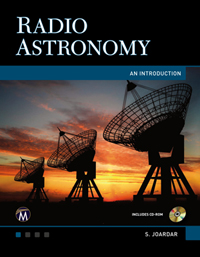 Radio Astronomy
Radio Astronomy
ISBN: 9781936420353
Pub Date: July 2015
Specs: 7 x 9 Hardcover with CD
Pages: 500
Price: $59.95
Designed for a course in radio astronomy or for use as a reference for practicing engineers and astronomers, this book provides a comprehensive overview of the topic. It begins with the history of radio astronomy then explains the fundamentals, polarization, designing radio telescopes, understanding radio arrays, interferometers, receiving systems, mapping techniques, image processing and propagation effects in relation to radio astronomy. A special chapter in the end presents the GMRT radio array as an example of the explained techniques. Two supplemental chapters have been added that describe the coordinate systems used in radio astronomy and minimum basics of antenna theory. The review questions at the end of each chapter contain direct hints for easy solutions.
BRIEF TABLE OF CONTENTS
1 Foundations of Radio Astronomy. 2 Fundamentals of Radio Astronomy. 3 Polarization Analysis.. 4 Designing Single Dishes and Phased Arrays. 5 Interferometry and Radio Arrays. 6 Receiving Systems. 7 Interferometer Aperture Synthesis and Radio Mapping. 8 Interferometer Data Calibration and Image Processing. 9 Propagation Effects in Radio Astronomy. 10 The GMRT Radio Array. Appendices. Bibliography. Index.
ABOUT THE AUTHOR
S. Joardar, PhD, is the senior engineer and scientific officer at the Tata Institute of Fundamental Research. He is a fellow of the Institute of the Electronics and Telecommunication Engineers and his major field of work has been in microwaves, antennas, astronomical radio spectrographs, RFI instrumentations, and data analysis for radio astronomy.
SHORT DESCRIPTION OF BOOK
Designed for a course in radio astronomy or for use as a reference for practicing engineers and astronomers, this book provides a comprehensive overview of the topic. It begins with the history of radio astronomy then explains the fundamentals, polarization, designing radio telescopes, understanding radio arrays, interferometers, receiving systems, mapping techniques, image processing and propagation effects in relation to radio astronomy.

